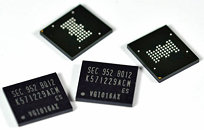Mar 17th, 2025 18:57 EDT
change timezone
Latest GPU Drivers
New Forum Posts
- DDR4 to DDR5 Advice (13)
- 9070 XT - 2x HDMI high refresh displays (144 and 120 Hz) not working (20)
- Is RX 9070 VRAM temperature regular value or hotspot? (7)
- Zen6 is almost here ? (73)
- revisiting hpet bcdedit tweaks: what are your timer bench results and settings? (105)
- 3DMARK "LEGENDARY" (287)
- Question about Intel Optane SSDs (13)
- Do you use Linux? (516)
- What is your 4090's Boost Clocks??? (20)
- Recommended PhysX card for 5xxx series? [Is vRAM relevant?] (197)
Popular Reviews
- AMD Ryzen 9 9950X3D Review - Great for Gaming and Productivity
- Sapphire Radeon RX 9070 XT Nitro+ Review - Beating NVIDIA
- ASUS GeForce RTX 5090 TUF Review
- MSI GeForce RTX 5070 Gaming Trio OC Review
- VAXEE Zygen NP-01S V2 Wireless Review
- XFX Radeon RX 9070 XT Mercury OC Magnetic Air Review
- Gigabyte X870E Aorus Pro Review
- Kioxia Exceria Plus G4 2 TB Review - Energy-Efficient PCIe Gen 5
- ASUS Radeon RX 9070 TUF OC Review
- AMD Ryzen 7 9800X3D Review - The Best Gaming Processor
Controversial News Posts
- NVIDIA GeForce RTX 50 Cards Spotted with Missing ROPs, NVIDIA Confirms the Issue, Multiple Vendors Affected (519)
- AMD RDNA 4 and Radeon RX 9070 Series Unveiled: $549 & $599 (260)
- AMD Mentions Sub-$700 Pricing for Radeon RX 9070 GPU Series, Looks Like NV Minus $50 Again (250)
- NVIDIA Investigates GeForce RTX 50 Series "Blackwell" Black Screen and BSOD Issues (244)
- AMD Radeon RX 9070 and 9070 XT Official Performance Metrics Leaked, +42% 4K Performance Over Radeon RX 7900 GRE (195)
- AMD Radeon RX 9070-series Pricing Leaks Courtesy of MicroCenter (158)
- MSI Doesn't Plan Radeon RX 9000 Series GPUs, Skips AMD RDNA 4 Generation Entirely (123)
- Microsoft Introduces Copilot for Gaming (120)
Wednesday, April 28th 2010

Samsung Ships Industry’s First Multi-chip Package with a PRAM Chip
Samsung Electronics Co., Ltd., the world leader in advanced semiconductor technology solutions, today announced the industry's first multi-chip package (MCP) with PRAM - for use in mobile handsets beginning later this quarter.
The 512 megabit Samsung PRAM in the MCP is backward compatible with 40 nanometer-class* NOR flash memory in both its hardware and software functionality, allowing mobile handset designers the convenience of having multi-chip packaging fully compatible with past stand-alone PRAM chip technology. PRAM is expected to be widely embraced by next year as the successor to NOR flash in consumer electronics designs, to become a major memory technology."Memories for portable consumer devices today are at a major turning point as mobile applications increasingly require more diverse memory technologies," said Dong-soo Jun, executive vice president, Memory Sales and Marketing, Samsung Electronics. "The launch of our PRAM in an advanced MCP solution for the replacement of 40nm-class and finer geometry NOR meets this need head-on. Our PRAM MCP will not only enable handset designers to utilize conventional platforms, but expedite the introduction of LPDDR2 DRAM and next-generation PRAM technology as the leading-edge basis for high-performance solutions," he added.
PRAM, which stores data via the phase change characteristics of its base material, an alloy of germanium, antimony and titanium, provides three-times faster data storage performance per word than NOR chips. This new PRAM-packaged memory combines the nonvolatile nature of flash memory with the high-speed capability of DRAM. Its simple cell structure makes designing MCP chips for handsets a faster and easier process, with the imminent use of 30nm-class and finer process node technology to overcome long-time design difficulties inherent in NOR flash technology.
As a replacement for NOR, PRAM can more easily accommodate the growing demand for high-speed, high-density nonvolatile memory in mobile phones and other mobile applications such as MP3 players, personal multimedia players and navigational devices.
Samsung is continuing its research and development into PRAM and other advanced memory chips to enable faster 'write' capabilities, a key feature in taking photo images, providing multimedia messaging and recording video clips to reduce the standby time in data storage. This high-speed write capability will be important in a diverse span of digital storage and consumer devices, such as solid state drives (SSDs) and HDTVs.
The 512 megabit Samsung PRAM in the MCP is backward compatible with 40 nanometer-class* NOR flash memory in both its hardware and software functionality, allowing mobile handset designers the convenience of having multi-chip packaging fully compatible with past stand-alone PRAM chip technology. PRAM is expected to be widely embraced by next year as the successor to NOR flash in consumer electronics designs, to become a major memory technology."Memories for portable consumer devices today are at a major turning point as mobile applications increasingly require more diverse memory technologies," said Dong-soo Jun, executive vice president, Memory Sales and Marketing, Samsung Electronics. "The launch of our PRAM in an advanced MCP solution for the replacement of 40nm-class and finer geometry NOR meets this need head-on. Our PRAM MCP will not only enable handset designers to utilize conventional platforms, but expedite the introduction of LPDDR2 DRAM and next-generation PRAM technology as the leading-edge basis for high-performance solutions," he added.
PRAM, which stores data via the phase change characteristics of its base material, an alloy of germanium, antimony and titanium, provides three-times faster data storage performance per word than NOR chips. This new PRAM-packaged memory combines the nonvolatile nature of flash memory with the high-speed capability of DRAM. Its simple cell structure makes designing MCP chips for handsets a faster and easier process, with the imminent use of 30nm-class and finer process node technology to overcome long-time design difficulties inherent in NOR flash technology.
As a replacement for NOR, PRAM can more easily accommodate the growing demand for high-speed, high-density nonvolatile memory in mobile phones and other mobile applications such as MP3 players, personal multimedia players and navigational devices.
Samsung is continuing its research and development into PRAM and other advanced memory chips to enable faster 'write' capabilities, a key feature in taking photo images, providing multimedia messaging and recording video clips to reduce the standby time in data storage. This high-speed write capability will be important in a diverse span of digital storage and consumer devices, such as solid state drives (SSDs) and HDTVs.
Mar 17th, 2025 18:57 EDT
change timezone
Latest GPU Drivers
New Forum Posts
- DDR4 to DDR5 Advice (13)
- 9070 XT - 2x HDMI high refresh displays (144 and 120 Hz) not working (20)
- Is RX 9070 VRAM temperature regular value or hotspot? (7)
- Zen6 is almost here ? (73)
- revisiting hpet bcdedit tweaks: what are your timer bench results and settings? (105)
- 3DMARK "LEGENDARY" (287)
- Question about Intel Optane SSDs (13)
- Do you use Linux? (516)
- What is your 4090's Boost Clocks??? (20)
- Recommended PhysX card for 5xxx series? [Is vRAM relevant?] (197)
Popular Reviews
- AMD Ryzen 9 9950X3D Review - Great for Gaming and Productivity
- Sapphire Radeon RX 9070 XT Nitro+ Review - Beating NVIDIA
- ASUS GeForce RTX 5090 TUF Review
- MSI GeForce RTX 5070 Gaming Trio OC Review
- VAXEE Zygen NP-01S V2 Wireless Review
- XFX Radeon RX 9070 XT Mercury OC Magnetic Air Review
- Gigabyte X870E Aorus Pro Review
- Kioxia Exceria Plus G4 2 TB Review - Energy-Efficient PCIe Gen 5
- ASUS Radeon RX 9070 TUF OC Review
- AMD Ryzen 7 9800X3D Review - The Best Gaming Processor
Controversial News Posts
- NVIDIA GeForce RTX 50 Cards Spotted with Missing ROPs, NVIDIA Confirms the Issue, Multiple Vendors Affected (519)
- AMD RDNA 4 and Radeon RX 9070 Series Unveiled: $549 & $599 (260)
- AMD Mentions Sub-$700 Pricing for Radeon RX 9070 GPU Series, Looks Like NV Minus $50 Again (250)
- NVIDIA Investigates GeForce RTX 50 Series "Blackwell" Black Screen and BSOD Issues (244)
- AMD Radeon RX 9070 and 9070 XT Official Performance Metrics Leaked, +42% 4K Performance Over Radeon RX 7900 GRE (195)
- AMD Radeon RX 9070-series Pricing Leaks Courtesy of MicroCenter (158)
- MSI Doesn't Plan Radeon RX 9000 Series GPUs, Skips AMD RDNA 4 Generation Entirely (123)
- Microsoft Introduces Copilot for Gaming (120)

5 Comments on Samsung Ships Industry’s First Multi-chip Package with a PRAM Chip
hmmm.... PRAM.... nah dosent work for me :P